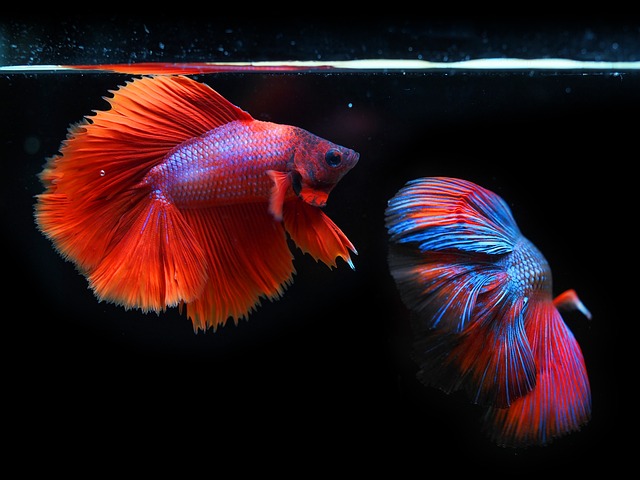Table of Contents
Can you put betta fish together? This is a question that many fish enthusiasts ask when they are considering adding a new fish to their aquarium. Betta fish are a prevalent choice for aquariums due to their striking colors and lengthy, flowing fins. However, there is some debate about whether or not betta fish can be kept together.
Betta fish are recognized for their aggressive conduct, particularly towards other male betta fish. In their natural habitat, male betta fish engage in fights over territory and mates. This behavior can also be seen in captivity, which is why it is generally not recommended to keep male betta fish together.
Female betta fish can sometimes be kept together, but it is important to monitor their behavior and make sure they are not fighting or showing signs of stress. In this article, we will explore the topic of keeping betta fish together and provide some tips for creating a peaceful community in your aquarium.
Understanding Betta Fish
Betta fish, also known as Siamese fighting fish, are popular pets due to their vibrant colors and flowing fins. They are native to Southeast Asia and are known for their aggressive behavior. In the wild, male bettas will fight each other for territory and mating rights.
Male bettas are more aggressive than females, and they should not be kept together. Accommodating two male bettas in the same tank will culminate in a fight to the death.
Female bettas can be kept together, but they may still show aggression towards each other. It is best to keep them in groups of three or more to minimize aggression.
Bettas are also known for their solitary nature. They do not require a lot of social interaction and can become stressed if they are housed with other fish. It is important to provide them with plenty of hiding places and plants to create a comfortable environment.
Betta Fish Habitat
When it comes to creating a suitable habitat for your Betta fish, there are a few key factors to consider. Betta fish are native to rice paddies and slow-moving streams in Southeast Asia, so it’s important to mimic their natural environment as much as possible.
First and foremost, the tank or aquarium should be large enough to provide plenty of swimming space for your Betta fish. A tank size of at least 5 gallons is recommended, but larger tanks are even better.
In addition to space, Betta fish also require hiding places and territories to call their own. You can provide these by adding plants, ornaments, and other decorations to the tank. A heavily planted tank is especially beneficial for Betta fish, as it provides plenty of hiding spots and creates a more natural environment.
When choosing plants for your Betta fish tank, it’s important to select species that are compatible with Betta fish. Some good options include Java fern, Anubias, and Amazon sword. These plants not only provide hiding spots, but also help to maintain water quality by absorbing excess nutrients.
Finally, it’s important to keep the water in your Betta fish tank clean and well-maintained. Betta fish are sensitive to changes in water chemistry, so regular water changes and proper filtration are essential.
Betta Fish Behavior
Betta fish, commonly referred to as Siamese fighting fish, are recognized for their aggressive conduct. They are territorial and frequently engage in fights with other fish, including those of their own species. This is particularly prevalent among male bettas, who are renowned for their striking colors and lengthy, flowing fins.
In the wild, bettas live alone in shallow waters such as rice paddies, swamps, and slow-moving streams. They are used to having their own space and will become aggressive if they feel that their territory is being invaded.
When kept in captivity, it is generally not recommended to keep male bettas together, as they will fight and often cause serious injury or death. However, female bettas can sometimes live together in a group known as a “betta sorority.
It is important to note that even female bettas can be aggressive towards each other, and it is recommended to keep at least 5-6 female bettas together in a tank to spread out any aggression.
When introducing new bettas to a tank, it is important to establish boundaries and introduce them slowly to prevent fighting. One technique is to use a mirror to allow the bettas to see each other without physical contact. This can help them establish dominance without causing harm.
Betta Fish Breeding
Breeding betta fish can be a rewarding experience, but it requires careful planning and preparation. Before attempting to breed bettas, you should make sure you have a suitable breeding pair.
To breed bettas, you will need a male and female betta fish. The male will build a bubble nest in the water, and the female will lay her eggs in the nest. After the eggs are laid, the male will fertilize them and then guard the nest until the fry hatch.
It is important to note that male and female bettas should not be kept together outside of breeding. They are aggressive and territorial fish and will fight each other if housed together for too long.
To prepare for breeding, you should provide the male with a suitable breeding tank with a temperature between 78-80°F and a pH level of 7.0. You should also provide plenty of hiding places for the female to retreat to if necessary.
Once the breeding pair is introduced to the breeding tank, the male will begin building the bubble nest. The female will then lay her eggs in the nest, and the male will fertilize them. After fertilization, the male will guard the nest until the fry hatch, which usually takes 24-48 hours.
Breeding betta fish requires patience and attention to detail, but with the right preparation, it can be a rewarding experience.
Betta Fish Tank Mates
If you are considering adding tank mates to your Betta fish aquarium, there are a few things to keep in mind. While Betta fish can be aggressive towards other fish, there are some species that can coexist peacefully. Here are some potential Betta fish tank mates to consider:
- Cory Catfish: These bottom-dwelling fish are peaceful and can help keep your tank clean.
- Guppies: These colorful fish are also peaceful and can add some variety to your aquarium.
- Tetras: Neon tetras and ember tetras are both good options for Betta fish tank mates. They are small and peaceful, and can add some color to your tank.
- Ghost Shrimp: These small crustaceans can help keep your tank clean and are unlikely to be bothered by your Betta fish.
- Kuhli Loaches: These eel-like fish are peaceful and can add some interest to your aquarium.
- Harlequin Rasbora: These peaceful fish are also good tank mates for Betta fish.
- Other Fish Species: While there are many other fish species that can coexist with Betta fish, it is important to research each species carefully before adding them to your tank. Some fish may be too aggressive or may require different water conditions than your Betta fish.
It is important to note that Betta fish should never be kept with goldfish or angelfish, as these species require vastly different water conditions. Additionally, it is not recommended to keep multiple Betta fish in the same tank, as they are territorial and may become aggressive towards each other.
When adding tank mates to your Betta fish aquarium, be sure to monitor their behavior closely. If you notice any signs of aggression or stress, it may be necessary to remove the new fish from the tank.
Introduction of New Fish
If you’re considering adding new fish to your Betta fish tank, it’s important to know how to properly introduce them to avoid any potential issues. Introducing new fish to your Betta’s environment can be a stressful experience for both the Betta and the new fish. It’s important to take the necessary steps to ensure the health and safety of all the fish in the tank.
Before introducing any new fish to your Betta tank, it’s important to quarantine them first. Quarantining new fish can help prevent the spread of diseases and parasites to your existing fish population. It’s recommended to quarantine new fish for at least two weeks before introducing them to your Betta tank.
When introducing new fish to your Betta tank, it’s important to do so slowly and gradually. Adding too many fish at once can cause stress and aggression among the fish. Start by adding one or two new fish at a time and monitor their behavior closely. If you notice any signs of aggression or stress, remove the new fish immediately.
It’s also important to choose fish that are compatible with Betta fish. Avoid adding fish that are known to be aggressive or territorial, as this can lead to fights and injuries. Some good options for tank mates include peaceful fish such as neon tetras, guppies, and corydoras.
Tank Conditions and Maintenance
When it comes to keeping Betta fish together, it is essential to maintain a healthy and stable environment. Proper tank conditions and maintenance play a crucial role in the health and well-being of your Betta fish.
Tank Size
The size of your fish tank is an essential factor to consider when keeping Betta fish together. Betta fish require a minimum tank size of at least five gallons, and it is always recommended to have more space than that. A larger tank provides more swimming space, which can help reduce aggression among Betta fish.
Water pH Level
Betta fish require a specific pH level to thrive, and it is essential to maintain the water’s pH level in your fish tank. The ideal pH level for Betta fish is between 6.5 and 7.5. You can test the pH level of your fish tank using a pH test kit, which is readily available at pet stores.
Bioload
Bioload refers to the amount of waste produced by your Betta fish. When keeping Betta fish together, it is essential to consider the bioload of your fish tank. Overcrowding your fish tank can lead to an increase in bioload, which can lead to poor water quality and health problems for your Betta fish.
Tank Dividers
If you decide to keep Betta fish together, using a tank divider can help reduce aggression and provide a safe environment for all your fish. A tank divider separates your fish tank into two or more sections, providing each Betta fish with their own space.
Maintenance
Maintaining your fish tank is essential when keeping Betta fish together. Regular water changes, cleaning the tank, and monitoring water quality are crucial to keeping your Betta fish healthy and happy. It is recommended to change 25% of the water in your fish tank every week and clean the tank every month.
Tips for Keeping Betta Fish Together
If you’re interested in keeping multiple betta fish together, there are a few things you should keep in mind. While it is possible to keep betta fish together, it’s important to do so carefully to ensure the health and safety of your fish.
It is crucial to acknowledge that not all betta fish can coexist. Male bettas, for instance, are recognized for their aggressiveness and should not be accommodated together. Female bettas, on the other hand, can sometimes be kept together in a group known as a sorority.
When keeping multiple bettas together, it’s important to provide plenty of space and hiding spots for each fish. This can be accomplished with the use of plants, toys, and rocks in the tank. Make sure to choose items that are safe for your fish and won’t harm them.
Another important factor to consider when keeping bettas together is the size of the tank. While bettas can survive in small tanks, it’s best to provide them with as much space as possible. A larger tank will also make it easier to create separate territories for each fish.
If you’re new to keeping bettas or are unsure about how to keep them together, it’s always a good idea to do some research and consult with a knowledgeable aquarium professional. They can provide you with tips and advice on how to create a safe and healthy environment for your fish.







